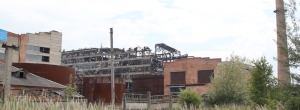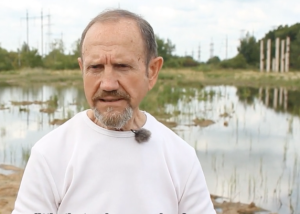New evidence reveals up to 1,600 tons HCB in a forgotten dumpsite.
By Tom Heinemann & Morten Hansen contaminatedfuture@gmail.com
From 2011 – 2014 large amount of the HCB-waste (hexachlorobenzene) was removed from Kalush to end the contamination in what is described as an “environmental disaster zone”. Or was it?
Various sources it’s now questioning what really happened in Kalush in the aftermath of the joint 2010 UN-EU scoping mission. After the report came out and huge amounts of money was allocated from Ukrainian authorities. They contracted with private companies to begin the much needed clean-up.
However, new information obtained by Contaminated Future, a “forgotten” dumpsite – close to the ones that was investigated by the EU/UN – reveals a grim story for local inhabitants and for the environment. Estimated 1,600 tons of HCB is buried here:
“The place which has been forested once had a field and a bushland, and also there were pits which were made with excavators. Here they dumped HCB (hexachlorobenzene) for three straight years, from 1973 to 1976”, says Mykhailo Dovbenchuk.
Mr. Dovbenchuk knows what he’s talking about. He used to work as a chemist at the factory, Oriana-Halev PLC and he was even participating in the dumping of the extremely hazardous chemicals back in the seventies:
“It’s still there. It wasn’t a part of what they removed”, says Mykhailo Dovbenchuk. Today he heads the local NGO, Green Movement Karparty.
When we meet Mykhailo Dovbenchuk in the outskirts of Kalush he points out how the dumping of HCB took place at two different sites. One is the “official” site called The Polygon:
“They removed the most safe part and they didn’t even looked at the storage from the first three years waste. Today there is a forest on top of this forgotten dumpsite. No one has tried to remove it (…)”
Later the “official” polygon was established and after 1976 the HCB-waste from the production was dumped more safely. The Polygon consisted of 12 pits with a sealing beneath. In each pit the barrels with HCB-waste was stored.
However, no one seemed to care about the “forgotten” dumpsite located just around 100 meters from the Polygon.
Kalush still heavily contaminated by HCB
The estimated production of HCB between 1973 to 1976 was annually 540 tons which means that there can be more than 1,600 tons just next to what was described as one of the most polluted and contaminated spots in Kalush and in “need of urgent attention”, as said in the joint UN-EU report from 2010. However, the report does not mention anything about the “forgotten” dumpsite.
According to Mr. Dovbenchuk the dumpsite is without any kind of protection.
According to the international organization; “Environment-People-Law” (EPL), headquartered in Lviv – north of Kalush, the concentration of the extremely toxic hexachlorobenzene exceeds the norm by half a million times, EPL environmentalist Alla Voytsikhovska stated during a press-conference on 6th of May 2015.
“At the end of March 2015 the EPL went to the hazardous waste landfill in Kalush and took samples of soil and water for further research”, Alla Voytsikhovska said.
The purpose was to challenge what EPL regards as the myths about the environmental status after the clean-up of hexachlorobenzene in Kalush.
According to the laboratory analysis conducted by the Ministry of Health in Ukraine the soil from Kalush had a concentration of HCB exceeding the norm from 164.000 times and up to 518.000 times the limits allowed by international standards.
The maximum norm is 0,03 mg/kg. In one of the samples analyzed, the authorities found 15,540,0 mg/kg of hexachlorobenzene (HCB) in the soil tested.
No vegetation
Mykhailo Dovbenchuk takes us to the area where the HCB was “officially” was dumped in The Polygon some 40 years ago:
“Take a look at the vegetation here. It was planted, it started to sprout, but eventually it died all the same. This means that something is killing it. The soil is bad here.” says Mykhailo Dovbenchuk. He is also concerned about the private wells that local people get their drinking water from.
Mykhailo Dovbenchuck at the "forgotten" dumpsite.
“No one can tell you if the underground water currents contains hexachlorobenzene. There is no monitoring of it in the wells from which people take their water. There is no environmental monitoring and control of the ground waters.”, says Mykhailo Dovbenchuk.
Yuri Sadoviy, head of the Kalush Gallurgy Insittute shares the concern:
“The Kalush Gallurgy Institute could provide the monitoring of wells, but the institute doesn’t get any support at all”.
Today Yuri Sadoviy and two other scientists works voluntarily at the institute:
“Our specialists have been waiting for five years now. But there is no work to do, because we have no money for salaries”.
The institute that once housed numerous scientists and researchers, is more or less abandoned. Several windows are smashed and walls are cracked.
“In Kalush there are still educated and experienced people who could monitor the situation, but we have no funds”, says Yuri Sadoviy in what seems to be the last remaining office – filled with charts, reports and documents.
The NGO, Green Movement Karparty states that private companies have been paid by the UN/EU to remove more HCB than ever produced in Kalush. According to Mr. Dovbenchuk, the production of HCB back in the seventies clearly can identify the amount of production and thereby also the amount of waste.
Adding up the numbers – something doesn’t match.
According to the scientific mission conducted by the UN/EU some 11,700 tons of HCB-waste should be removed from Kalush starting at the summer of 2012 and ending in 2013.
However, an inventory done by the National Institute of Geochemistry of Environment of National Academy of Science of Ukraine later confirmed some new and shocking figures:
Suddenly the amount of toxic HCB-waste was about 29,000 tons.
A part of the explanation is the way the private entrepreneurs handled the toxic waste. International standards often use “by the ton” when it comes to calculate a certain amount of waste that has to be removed.
However, the Ukrainian media published several articles implying that there had been fraud with money allocated by the Ukrainian authorities for the cleanup. According to Ukrainian media, some 159 mio. USD were spend.
And in another media report from The Kyiv Post, the private entrepreneurs simply mixed the highly toxic HCB with soil surrounding the rusty barrels and piles of waste.
And suddenly 11,700 ton of waste became 29,000 – and no one seemed to care.
After the international experts left Kalush in 2010 a money machine apparently was made.
HCB crossing borders
12,000 tons of the HCB-waste from Kalush was transported to Gdansk in Poland.
Here it was stored – but hardly protected on the brinks of the Baltic Sea.
Environmentalists and experts were alarmed and the disposal of the HCB-waste created a local scandal in 2012.
The transportation was insecure, the storage was risky and the polish company’s ability to destroy the waste in a safe way, were questioned by different experts and environmental organisations.
The company was later fined € 1.4 million for having kept the HCB-waste outdoors and in partially destroyed big-bags with no protection against rain, flooding and wind. Only few meters away from the Baltic Sea.
Finn Bro-Rasmussen, professor emeritus and former chairman of the EU Scientific Committee on Toxicology and Ecotoxicology (CSTE) have repeatedly warned about how the HCB-waste was supposed to be treated in Poland:
“The problem is that the incinerator plant in Gdansk is not technical sufficiently developed to deal with such a difficult chemical as HCB – so we risk atmospheric and/or aquatic pollution. They have tried to solve some of the problem by transporting some of the chemical in land but the storage is not good enough and the now risk that it will enter the Polish waterways.”
Carcinogenic HCB by the Baltic Sea
In this film you can see what happend with the HCB in Poland:

